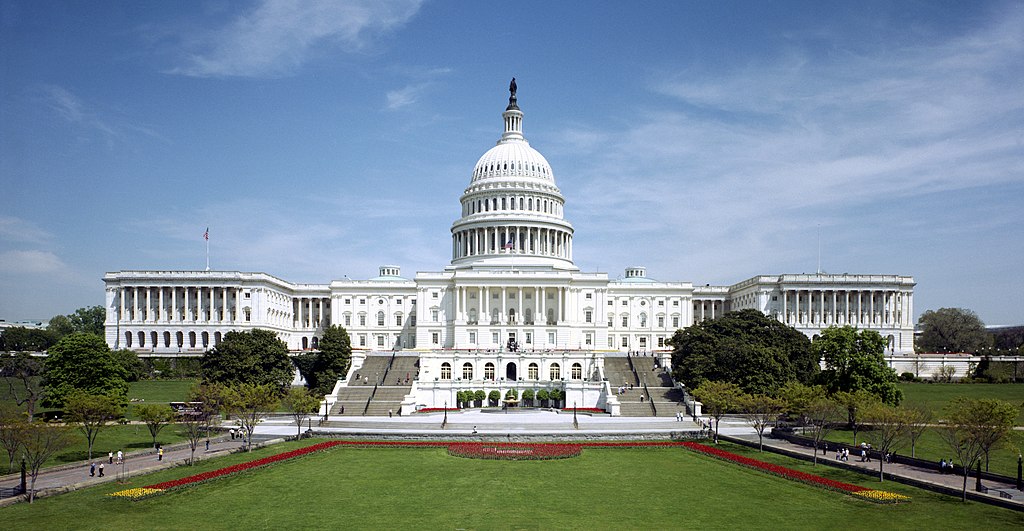Congress Adapts to Calamity: The FY 2018 NDAA’s Climate Change Provisions
President Donald Trump is expected to sign the National Defense Authorization Act (NDAA) for fiscal year 2018 into law in the next few days.

Published by The Lawfare Institute
in Cooperation With

President Donald Trump is expected to sign the National Defense Authorization Act (NDAA) for fiscal year 2018 into law in the next few days. As Scott Anderson pointed out in his summary of the NDAA’s most interesting provisions, the bill continues in the tradition of prior NDAAs by creating “sprawling documents that contain provisions on a diverse range of subjects, any of which can have a substantial bearing on U.S. national security.” One such provision that Scott highlighted is Section 335, which provides some guidance to the military on how it should deal with climate change, given that it is, as the provision declares, “a direct threat to the national security of the United States.”
Rep. Jim Langevin (D-R.I.) introduced the climate change amendment to the NDAA to highlight that, as Langevin put it, “climate change is real, and it will have a devastating effect on the readiness of our armed forces.” Another amendment from Rep. Scott Perry (R-Pa.) challenged the Langevin amendment almost immediately, seeking to remove Langevin’s provision from the bill. The Perry amendment was ultimately defeated in the House by a 185-234 vote (including 46 Republicans who opposed the deal), and Langevin’s amendment survived.
The provision, which relies heavily on statements from former and current military and intelligence officials, directs Defense Secretary James Mattis—whose prior statements feature prominently in the “Findings” section—to submit a report within one year on the “vulnerabilities to military installations and combatant commander requirements resulting from climate change over the next 20 years.”
The report must include the following:
- “A list of the ten most vulnerable military installations . . . based on the effects of rising sea tides, increased flooding, drought, desertification, wildfires, [and] thawing permafrost”;
- An overview of “mitigations that may be necessary to ensure the continued operational viability and to increase the resiliency of the identified vulnerable military installations”;
- An explanation of the effects of climate change on the Defense Department overall, “including the increase in the frequency of humanitarian assistance,” and the effects on “theater campaign plans, contingency plans, and [the] global posture of the combatant commanders”; and
- “An overview of mitigations that may be necessary to ensure mission resiliency”.
The provision will, on its face, be heartening to those who want action on climate change, in that it places an affirmative obligation on the military to examine its effects. Section 335’s focus on “vulnerable military installations” is a politically clever way of bringing the problem to the foreground of the policymaking agenda. It mentions that sea-level rise may threaten “more than 128 United States military sites,” including a $1 billion Air Force radar installation that is “projected to be underwater within two decades.” Other at-risk military installations not mentioned include the Navy’s largest base in Norfolk, Virginia (“the fifth most endangered”) and other military bases in Florida, Bahrain, Guam and Diego Garcia. Losing these bases would be extremely costly and destabilizing. Additionally, the provision’s focus on the quickly thawing Arctic and increased geopolitical instability from “failed states” stemming from extreme climate events is clearly an attempt to add political urgency to the climate debate by linking it to important U.S. strategic security goals.
But the climate change provision is as important for what it doesn’t require as for what it does. First, unlike with other national-security priorities articulated in the NDAA, like cyber operations (section 1633) and space warfighting (section 1601), Congress doesn’t require that Mattis develop a policy to solve the problem that it acknowledges climate change poses. Instead, it merely requires that the secretary provide an explanation of its “effects.” This was probably intentional on the part of Congress, given how politically controversial climate change is, and given that the military is supposed to be apolitical—and that the military is, in any event, not the agency responsible for regulating carbon emissions. While the requirement that Mattis produce a report on the “mitigations” necessary to ensure “resiliency” could be construed as, in effect, requiring the creation of a policy response, the fact remains that there is no explicit direction that he implement the mitigations on which he’ll be reporting.
Second, and perhaps more importantly, the provision does not provide a definition of what “mitigations” means. Given that “resiliency” is mentioned in the same breath as “mitigations,” it appears that Congress intends for Mattis to examine how the military will prepare for the future impacts of climate change. Notably, this is not the use of the word “mitigation” that climate change policy tends to deploy.
The responses to climate change since the 1970s have fallen largely into two paradigms. The first is mitigation, or reducing the flow of greenhouse gases into the atmosphere. Mitigation is best represented by efforts like weaning countries off of fossil fuels and in turn ramping up the use of renewable energy technology like solar panels, wind turbines, and nuclear power plants. The second is adaptation, or adjusting our environment to accommodate the effects of climate change. Efforts like Miami’s project to reengineer its roads and seawalls to raise them above rapidly increasing sea levels are examples of adaptation. To put the matter briefly, mitigation generally focuses on the sources of climate change; adaptation focuses on its consequences.
Congress, in requiring the armed services to focus on “resilience,” seems to be embracing an adaptation approach to climate change, while leaving mitigation entirely out of the equation. Conversely, the primary focus of efforts to combat climate change since the adoption in 1992 of the United Nations Framework Convention on Climate Change—the treaty-based framework that facilitates international action on climate change, including the 2015 Paris Agreement—have always focused on mitigation as the most scientifically-effective means of addressing the issues of climate change. While adaptation has become a serious policy objective with accords like the Paris Agreement, this transition was largely due to a lack of political will on mitigation, and determinations that society could handle some of climate change’s effects, but not all.
Mitigation efforts are, of course, a little harder to connect with U.S. strategic objectives than, say, adaptations for coastal bases that will otherwise sink into the sea. But the military actually is an excellent vehicle to promote mitigation. According to the Congressional Research Service, as of 2012, the Department of Defense was “the largest organizational user of petroleum in the world.” Among the many military vehicles currently employed by the armed services are the Navy’s 308 ships, ten of which are mammoth aircraft carriers. The vast majority of these ships use thousands of tons of fossil fuels each year. And the thousands of aircraft in the military’s employ accounted for 22 percent of all jet fuel used by the United States as of 2008.
Congress is not naive about how to draft legislation that combines both mitigation and adaptation. A decade ago, Sen. Joseph Lieberman (I-Conn.) introduced the America’s Climate Security Act of 2007, which focused on mitigation and provided numerous avenues for pursuing adaptation (including an “Adaptation Fund"), with bipartisan support, though the bill ultimately died in the Senate before being brought to a vote. So we should probably understand the congressional focus on adaptation for the military now as an intentional choice.
Interestingly, the military, realizing its contribution to the emission of greenhouse gases, has made progress on mitigation. Many of these efforts have been driven by a strategic desire to make the U.S. armed forces more energy-independent, as set forth in a 2008 Defense Science Board Task Force report. Back in 2006, the military began the research process of developing alternative fuels under the direction of then-Defense Secretary Donald Rumsfeld, who convened a task force to wean the military off of petroleum. The effort pushed forward in earnest in 2009 as the Navy began research on the use of algae-derived biofuel for its jets and aircraft carriers. A demonstration by the Pacific fleet in 2012, which became known as the “Great Green Fleet,” signaled that use of alternative fuels made from algae and chicken fat was possible (though the program has been much maligned by critics, mainly conservative lawmakers, as a costly venture that might not produce the desired results). And the Fleet is but one widely reported part of a multi-pronged effort by the military to address energy issues over the last decade, one that also includes efforts to create three gigawatts of renewable energy on Army, Navy, and Air Force installations by 2025; a Defense Advanced Research Projects Agency (DARPA) initiative to improve energy storage in battlefield devices; and Marines deploying solar panels and blankets at bases in Afghanistan.
These efforts have largely continued under the Trump administration. Earlier this year, I highlighted how Mattis’s statements and efforts surrounding climate change could likely provide a “beacon of hope” in this area. I also mentioned that Congress might be able to provide that beacon with fresh fuel through legislation. It seems that Congress has followed Mattis’s lead and started to do so—albeit tentatively and cautiously.



.jpg?sfvrsn=4ae453c9_8)

